#rare fossil matrix
Explore tagged Tumblr posts
Photo

Fossil Fish Teeth Bones & Coprolite Block | Westbury Formation | Upper Triassic Aust Cliff UK | Authentic Specimen
This listing is for an exceptional and genuine fossil block containing fish teeth, fish bones, and coprolite (fossilised faeces), discovered in the famous fossil-bearing strata of Aust Cliff, located near Bristol, UK. The specimen originates from the Westbury Formation, part of the Penarth Group, dating back to the Upper Triassic Period (~208–201 million years ago).
This richly fossiliferous layer is world-renowned for its diverse vertebrate fossil assemblage, often referred to as the "fish, reptile and coprolite bed". The block offers a rare combination of preserved fish elements and coprolite, highlighting a dynamic nearshore marine depositional environment likely associated with a lagoonal or estuarine setting with variable salinity.
The fossil remains include small bones and well-preserved teeth, some attributable to prehistoric genera like Severnichthys and others possibly linked to early ray-finned fishes and primitive sharks. The coprolite present is often linked to larger fish or marine reptiles, offering insight into feeding behaviour and paleoecology.
Geological Context:
Formation: Westbury Formation
Group: Penarth Group
Age: Late Triassic (Rhaetian Stage)
Location: Aust Cliff, near Bristol, England
Depositional Environment: Shallow marine/lagoonal, occasionally brackish
Biozone: Rhaetian bone bed, no narrower zone designation possible from available data
Fossil Features:
A multi-fossil matrix including fish teeth, fish bones, and dark mineralised coprolite
Distinctive from this rare UK site, known for significant vertebrate fossils
Cleaned, stabilised, and preserved by our preparator Alison
Specimen Discovery & Treatment: Discovered on 07 April 2025 by our own team members, Alister and Alison. Carefully prepared, cleaned, and treated for long-term preservation by Alison.
Scale cube shown in photo = 1cm. Please see photos for exact sizing and specimen detail.
Authenticity Guarantee: All of our fossils are 100% genuine specimens and come with a Certificate of Authenticity.
This is the actual fossil you will receive — a one-of-a-kind glimpse into the Late Triassic marine world.
#Fossil fish teeth#fish bones#coprolite fossil#Aust Cliff fossil#Westbury Formation#Penarth Group#Upper Triassic fossil#UK Triassic fossil#reptile coprolite#fossil bone bed#fish fossil UK#Alister Alison discovery#genuine fossil specimen#certificate of authenticity#paleontology collectible#fossil bed Bristol#Triassic fossil block#rare fossil matrix#UK fossil dig
0 notes
Text
Aliens are floored by tardigrades
Life is pretty resilient. It has to be, especially if the rest of the Galaxy thinks we're from a Deathworld. In comparison then, if their planets are not as demanding, would life there ever be under enough pressure to survive to go to the extreme lengths that some Earth creatures do? I think one of the most profound things aliens might learn from Earth and Humanity is just how powerful life itself can be.
That itself could shake their understanding of themselves - a billion year old civilization could never even conceive of a thing we accept as simple fact, ushering a revolution in thinking not seen in eons.
___________________________
The Galactic Coalition scientists are busying themselves with obtaining, analyzing, categorizing, and integrating the libraries of information Humanity has brought with them as they incorporate into the greater space faring matrix of civilizations.
A good grasp of Physics, though lacking in certain fields for now; unmatched Engineering doctrines, they really do think of everything, although, perhaps, better to say - they really do attempt everything, then take notes and improve for the next attempt.
Chemistry is another fine addition to the collective knowledge base, a disproportionate part of the catalogue is comprised entirely of explosive reagents and combinations - always good to know more about what NOT to do.
And Biology. Oh boy. What a chaotic but beautiful but also disturbing mess. Life on most planets has a long period of just chugging along, surviving as best it can, until eventually something has the bright idea to evolve the ability to have bright ideas. Then in almost no time at all (on a cosmic scale) a dominant intelligence emerges and civilization alongside it, and in the blink of an eye it finds itself exploring the stars.
A similar pattern happened on Earth, but interrupted alarmingly often by utter catastrophes. Humans call them Mass Extinctions. It is exceedingly rare to find life that can talk about its own extinction events. Kind of deflates the term a bit. Life on planets as inhospitable (by Galactic norms) as Earth tends to be found only as fossils, and almost always on the microscopic level - very rarely do they get the chance to form more complex and advanced lifeforms before the planet with its harsh conditions and scarce resources kills it just as randomly as it spawned it.
We were incredibly saddened to learn from the Humans that the biodiversity of Earth had dwindled by roughly 85% since they accidentally created that giant hole on their planet, and that it had already been on a steady decline before then. Even so, when they revealed there were still 2.4 million species alive on Earth was a shockingly high number. Most are on the brink of extinction, yes, but the fact remains that Earth is easily one of the most biodiverse planets in the Galaxy.
Then we started looking at each individual species and learned about the Tardigrade.
what
It is literally the toughest creature ever discovered, and it's not even close. At least, so far, we haven't looked at absolutely everything Earth has or had yet.
It can just... basically turn itself off and then back on again when the outside becomes livable again - Cryptobiosis, or suspending their metabolism, something we considered only possible through artificial means. And the levels of various extreme they can endure and still be alive would just be utterly ridiculous if they didn't give us samples to confirm for ourselves.
Then we came across the term Extremophile and just decided to take a day off.
#earth is weird#earth is space australia#earth is a deathworld#nature is weird#tardigrade#that's how my brain works#I too learned of that term only now#so it was time to stop before things got out of hand#carionto
450 notes
·
View notes
Text

Curled tightly in a near-perfect fetal position, the fossilized skeleton of a young dinosaur rests preserved within ancient sediment. Its delicate bones remain articulated, offering a lifelike glimpse into a moment frozen in time. The fine details of its vertebrae, limbs, and claws reveal how swiftly this creature must have perished and been buried, a rare event that allowed for such exceptional preservation. Enclosed in a stone matrix, this fossil serves as a hauntingly intimate snapshot of prehistoric life, as though the dinosaur had simply fallen asleep and never woken, forever immortalized by the slow passage of millennia.
#Paleontology
#DinosaurFossil
23 notes
·
View notes
Note
Idrc what the Matrix is. Has anyone licked it. What does it taste like.
C.O.G.S. Reply: Taste Testing the Matrix 🤔🍴
👀 Alright, alright... Here's the scoop 👀
Thank you for your inquiry! 🫡 After an exhaustive, and totally scientific, review of historical, mythological, and speculative records regarding the Matrix of Leadership, the C.O.G.S. team has determined the following:
Has anyone licked the Matrix?
…There is no confirmed documentation of a direct lick. However, given the number of suspicious "handling accidents", we cannot officially rule it out. 🤨🔬
In the spirit of scientific inquiry, we did reach out to the staff of Rodimus Prime for clarification. Unfortunately, our polite request to conduct "direct experimental taste testing in the name of the greater good" was vetoed immediately by a multitude of Senior Archivists on grounds of "basic dignity" and "risk of spontaneous narrative consequences."
BUT (because we never back down from a challenge 💪), we took the next best route: the power of hypothetical scenarios. Here’s a taste ranking of what we think the Matrix might maybe possibly taste like:
Metallic-y & Charged ⚡️ - Our first guess. No surprise here, considering the Matrix’s techy vibe. Impromptu experiments and a thorough cross examination of resulting notes has reached the consensus among us interns that licking a battery or a very dignified piece of silverware would be the closest comparison.
Almonds - After compiling insights from various sources (including our invaluable human archaeology contact, Elena Wallace, who informs us that taste testing is a genuine method of fossil identification), we decided to put forward a vote for an almond flavored Matrix. This is based on reports from organic archeologist that so-called 'fossils' occasionally take on such a taste.
Low-grade Engex - This hypothesis came to the C.O.G.S team in a rare moment of inspiration following contact with the Archive bureaucracy. After presenting our query to the higher ups, one studious bot up a Mecha Resources asked what grade of engex we were drinking. Thus, we took an experimental angle and approached the question following the use of various grades. The low-grade test group was the only one left with readable notes.
Keep in mind, this is all theory... But if you ever find yourself with a piece of the Matrix in hand and a very brave glossa 🤨👅... Let us know how it goes! C.O.G.S. takes no responsibility for any future Matrix-licking initiatives inspired by this post.
We hope this clarifies your curiosity! Feel free to submit additional scientifically-questionable questions at any time. 🔎📝
— C.O.G.S., documenting the important stuff since...well, at least since Tuesday.
#matrix taste test#cogs archives#transformers one#weird science#taste testing#engex#sci-fi research#rodimus prime#hypothetical flavors#archives of iacon#transformers#transformers community#transformers fanfiction#transformers roleplay#digital archives#optimus prime#orion pax#archives bulletin#c.o.g.s.#ask box#ask
24 notes
·
View notes
Text

Astronomers discover new evidence of intermediate-mass black holes
In the world of black holes, there are generally three size categories: stellar-mass black holes (about five to 50 times the mass of the sun), supermassive black holes (millions to billions of times the mass of the sun), and intermediate-mass black holes with masses somewhere in between.
While we know that intermediate-mass black holes should exist, little is known about their origins or characteristics—they are considered the rare "missing links" in black hole evolution.
However, four new studies have shed new light on the mystery. The research was led by a team in the lab of Assistant Professor of Physics and Astronomy Karan Jani, who also serves as the founding director of the Vanderbilt Lunar Labs Initiative.
The primary paper, "Properties of 'Lite' Intermediate-Mass Black Hole Candidates in LIGO-Virgo's Third Observing Run," was published in Astrophysical Journal Letters and led by Lunar Labs postdoctoral fellow Anjali Yelikar and astrophysics Ph.D. candidate Krystal Ruiz-Rocha. The team reanalyzed data from the Nobel-Prize winning Laser Interferometer Gravitational-Wave Observatory (LIGO) detectors in the U.S. and the Virgo detector in Italy.
The researchers found that these waves corresponded to mergers of black holes greater than 100 to 300 times the mass of the sun, making them the heaviest gravitational-wave events recorded in astronomy.
"Black holes are the ultimate cosmic fossils," Jani said. "The masses of black holes reported in this new analysis have remained highly speculative in astronomy. This new population of black holes opens an unprecedented window into the very first stars that lit up our universe."
Earth-based detectors like LIGO capture only a split second of the final collision of these "lightweight" intermediate-mass black holes, making it challenging to determine how the universe creates them. To tackle this, Jani's lab turned to the upcoming European Space Agency and NASA's Laser Interferometer Space Antenna (LISA) mission, launching in the late 2030s.
In two additional studies published in The Astrophysical Journal, "A Sea of Black Holes: Characterizing the LISA Signature for Stellar-origin Black Hole Binaries," led by Ruiz-Rocha, and "A Tale of Two Black Holes: Multiband Gravitational-wave Measurement of Recoil Kicks," led by former summer research intern Shobhit Ranjan, the team showed LISA can track these black holes years before they merge, shedding light on their origin, evolution, and fate.
Detecting gravitational waves from black hole collisions requires extreme precision—like trying to hear a pin drop during a hurricane. In a fourth study also published in The Astrophysical Journal, "No Glitch in the Matrix: Robust Reconstruction of Gravitational Wave Signals under Noise Artifacts," the team showcased how artificial intelligence models guarantee that signals from these black holes remain uncorrupted from environmental and detector noise in the data. The paper was led by postdoctoral fellow Chayan Chatterjee and expands upon Jani's AI for New Messengers Program, a collaboration with the Data Science Institute.
"We hope this research strengthens the case for intermediate-mass black holes as the most exciting source across the network of gravitational-wave detectors from Earth to space," Ruiz-Rocha said. "Each new detection brings us closer to understanding the origin of these black holes and why they fall into this mysterious mass range."
Moving forward, Yelikar said the team will explore how intermediate-mass black holes could be observed using detectors on the moon.
"Access to lower gravitational-wave frequencies from the lunar surface could allow us to identify the environments these black holes live in—something Earth-based detectors simply can't resolve," she said.
In addition to continuing this research, Jani will also be working with the National Academies of Sciences, Engineering, and Medicine on a NASA-sponsored study to identify high-value lunar destinations for human exploration to address decadal-level science objectives.
As part of his participation in this study, Jani will be contributing to the Panel on Heliophysics, Physics, and Physical Science, to identify and articulate the science objectives related to solar physics, space weather, astronomy, and fundamental physics that would be most enabled by human explorers on the moon.
"This is an exciting moment in history—not just to study black holes, but to bring scientific frontiers together with the new era of space and lunar exploration," Jani said. "We have a rare opportunity to train the next generation of students whose discoveries will be shaped by, and made from, the moon."
TOP IMAGE: Left: posterior distribution of the chirp mass of the binary in the source frame as a function of the inferred effective inspiral spin parameter. Right: posterior distributions of the mass and the dimensionless spin of the remnant black hole according to the RIFT inference using the NRSur7dq4 model. The two-dimensional plot for both panels shows the 90% credible regions of inference using RIFT with the NRSur7dq4 model. The thick grey and filled black posteriors represent the LVK posterior distributions for GW170502 and GW190521, respectively, with the NRSur7dq4 waveform model. Credit: The Astrophysical Journal Letters (2025). DOI: 10.3847/2041-8213/adc5f8
LOWER IMAGE: A GW190521-like BBH system, with recoil kick configurations: 68 km s−1 (red curve) and 1006 km s−1 (green curve). Both systems differ only in their in-plane spin angles. Credit: The Astrophysical Journal (2025). DOI: 10.3847/1538-4357/adba4e

2 notes
·
View notes
Text

The cosmic transmutation in dinosaur fossils
I propose the nuclear- idea, tying it directly to the rapid mineralization of fossils:
Cosmic Transmutation and the Role of Hydrogen
. Cosmic Synthesis of Matter It is well-established in astrophysics that heavier elements such as silicon, iron, gold, and even rare earth metals are not formed under typical Earth conditions. Instead, they are forged in the hearts of stars and during catastrophic cosmic events such as:
• Supernovae (explosions of massive stars).
• Neutron star mergers
• Gamma-ray bursts and cosmic ray interactions.
These events generate the necessary pressure, temperature, and particle flux to convert simple atoms like hydrogen into a wide array of elements through nuclear fusion and neutron capture processes. 6.2. Hydrogen-Rich Tissue as a Cosmic Medium Dinosaur bones, like all biological tissues, are rich in hydrogen, primarily due to the water (H₂O) content and organic compounds. Under standard Earth conditions, this hydrogen remains chemically stable. However, exposure to a high-energy cosmic force (e.g., radiation burst, plasma flux, exotic particle field) could theoretically:
• Disrupt molecular bonds.
• Introduce high-energy particles or magnetic fields
• Catalyze transmutation or crystallization of elements within the tissue matrix In such a scenario, hydrogen atoms within the tissue could act as the foundation for elemental transformation—either by directly participating in nuclear processes or by serving as catalysts for the deposition of silicates, forming quartz-like structures. 6.3. Quartz and Silica Formation via Cosmic Influence Quartz (SiO₂) and silica-based minerals are common products of post-supernova ejecta, as well as planetary cooling influenced by cosmic silicon dust. If a cosmic event influenced Earth’s environment—either through atmospheric interaction or direct energy deposition—it could plausibly:
• Inject silicon or catalyze its crystallization from local silica-rich environments
• Activate rapid silicification of hydrogen-rich biological matter
• Result in petrification that mimics the structural integrity of live tissue This could explain the near-perfect preservation of cellular and vascular structures in fossilized dinosaur bones—something unlikely under slow permineralization alone.
My hypothesis integrates cosmic-origin matter transformation, suggesting that cosmic-scale forces may not only shape the universe but could also interact with biological material on Earth in ways that challenge traditional models. Through cosmic transmutation, hydrogen-rich organic remains could have been transformed into durable mineral forms like quartz in a rapid, non-linear process.
Would my hypothesis explains several key fossilization mysteries?
Explanation of instantaneous petrification via high-energy cosmic flash events: Instantaneous Petrification via Light-Speed Cosmic Energy Bursts Building on the principle that cosmic forces act at or near the speed of light, we propose that certain fossilization events were triggered by a brief but intense energy burst—akin to a cosmic flash event that interacted with hydrogen-rich dinosaur remains at or near the surface of the Earth. Key aspects of this process:
• Speed of Light Reaction: The energy possibly electromagnetic, photonic, or plasma-based would have acted in fractions of a second, petrifying the outer layers of biological tissue before it could penetrate the interior.
• Capsule Effect: The outer petrified shell acted as a protective barrier, sealing the internal tissues from air, moisture, bacteria, and decomposition. This explains why structures such as blood vessels, soft tissues, or even cellular remains could be preserved for millions of years without decaying.
• Energy Penetration Limitation: The extreme density and mineralization of the petrified outer shell (e.g., silicified or quartz-like matrix) may have prevented the energy from fully permeating deeper structures. Thus, only the outer layers fossilized, while inner sections remained biologically preserved, albeit protected by the mineral “capsule.” This mechanism can account for puzzling findings such as:
• Intact soft tissue in T. rex femurs, where degradation should have occurred over geologic time.
• Selective fossilization, where exterior features are mineralized but interiors remain partly organic or semi-structured. • Preserved biomolecules (e.g., collagen, heme, even DNA fragments in rare cases) under layers of dense fossil material.
Scientific Implications If such instant cosmic petrification events occurred, they would require:
• A cosmic burst aligned with Earth’s surface at a specific angle and intensity.
• Pre-existing water-rich biological remains in the path of the burst.
• Possibly, a rare atmospheric or planetary condition that allowed or focused this event. The implications of such events would reshape our understanding of:
• Paleontological preservation mechanisms.
• Interactions between astrophysics and biology.
• The timeline and mechanisms of mass extinction and fossilization Yes, there is strong scientific evidence that a supernova (or multiple) occurred close enough to Earth in the past few million years to leave measurable traces:
Evidence of Past Supernovae Reaching Earth:
1. Iron-60 Isotopes in Earth’s Crust • Iron-60 (⁶⁰Fe) is a radioactive isotope that does not naturally occur on Earth in detectable amounts.
• It has been found in deep-sea sediments, Antarctic snow, and lunar soil samples.
• These isotopes date back to around 2–3 million years ago, indicating that a nearby supernova exploded and deposited material on Earth.
2. Location: Likely Within 100–300 Light-Years
• The suspected supernova likely occurred within this range close enough to affect Earth’s environment, but far enough to avoid total extinction.
• Such an event could send cosmic rays, shock waves, and high-energy particles that reach Earth.
3. Impact on Earth
• These supernovas could have contributed to climate change, ozone layer thinning, and possibly even mass extinctions.
• A supernova shockwave interacting with Earth’s magnetosphere or atmosphere could trigger electromagnetic bursts, particle showers, or gamma radiation exposure.
What could have happened past supernova events hit Earth:
• It could have delivered a flash of energy traveling at light speed.
• That energy could have petrified exposed biological remains in fractions of a second.
• This aligns with the capsule effect, partial fossilization, and soft tissue preservation observed in some dinosaur fossils and would cause localized geological transformations aligned with fossil preservation anomalies. The timing and nature of these events support the hypothesis that cosmic forces could be responsible for fossilization processes previously thought to take millions of years.

A microscopic dinosaur bone
2 notes
·
View notes
Text
So is he again finding fossiled distant sea urchins ?
Searched & found old echinoids !!!


Three echinodem found today.
An tiny embeded core in an piece of chert- flint stone matrix like the previous one. Same size but from other location in the 10 km radius.
Than one absolutely near complete marble round in grey. So tiny treasure. 🥹
The third under light an pale rose‘ color, chestnut sized near half+ of it.
Some shards of chert in red orange hue and some little Wallstones. And an piece of echinoid.
I must say from the last trips, dark black or brown flint here is rarely seen now, more the gray to orange pale and reddish in colors.


#fossils#geology#fossil hunt#fossil collecting#fossil#fossil friday#echinoids#echinoid#sea urchin#fossils in germany
7 notes
·
View notes
Text
Hydrogen Power Plant: The Future is Not a Dream—It's Under Construction
Imagine a world where the fuel that powers our cities, industries, and even vehicles is so clean it emits only water. Not smoke. Not carbon. Just vapor that disappears into the air. Sounds futuristic? It’s not. The hydrogen power plant is no longer a fantasy scribbled in engineering notebooks—it’s a rapidly emerging reality in our journey to decarbonize the planet.
Let’s break this down—not just with technical jargon, but with a story that makes this transformative innovation real.
The Fossil Fuel Hangover
We’re living through an energy identity crisis. For decades, we’ve leaned heavily on fossil fuels—coal, oil, and natural gas. They’ve powered our growth, lit our homes, and moved our economies. But we’re now facing their long-term cost: rising global temperatures, polluted air, and a climate tipping dangerously close to irreversibility.
Transitioning away from fossil fuels is no longer optional—it’s existential. And while solar and wind are crucial players in this transition, they have their limitations: intermittency, land use, and storage complexities.
That’s where the hydrogen power plant comes into play.
What Is a Hydrogen Power Plant?
In simplest terms, a hydrogen power plant uses hydrogen as fuel to generate electricity. This can be done in multiple ways:
Combustion-based hydrogen turbines (like natural gas turbines).
Fuel cell-based plants, where hydrogen reacts electrochemically to produce electricity.
The only emission? Water.
But the real magic lies upstream: how we produce hydrogen. When generated via electrolysis using renewable electricity (solar/wind), the result is “green hydrogen”—a zero-emissions cycle from start to finish.
Why Hydrogen? Why Now?
Hydrogen is the most abundant element in the universe. But here’s the twist—it rarely exists on Earth in its pure form. So we extract it from water (H₂O) or hydrocarbons. Producing it cleanly is the challenge.
So, why is everyone—from governments to oil giants to startups—suddenly excited about hydrogen?
Energy Storage: Hydrogen can store excess renewable energy and release it on demand.
Hard-to-Decarbonize Sectors: Think steel, cement, shipping, and aviation.
Grid Balancing: Hydrogen power plants can be switched on quickly to stabilize electrical grids during peak demand.
In other words, it’s not just about replacing coal plants. It’s about rethinking the energy matrix entirely.
A Real-World Story: From Desert to Power Hub
Take the project in NEOM, Saudi Arabia—a futuristic city being built in the desert. It’s set to host one of the largest hydrogen power plant ecosystems in the world. Powered entirely by solar and wind, the facility will produce green hydrogen at scale for both local use and export.
This isn’t a science experiment. It’s a $5 billion commitment to the energy of tomorrow, today.
And it’s not alone—similar efforts are underway in Germany, Australia, Japan, and even India. Hydrogen isn’t waiting for an invitation. It’s already showing up at the party.
Technical Deep Dive (Without the Pain)
Let’s demystify what happens inside a hydrogen power plant:
Hydrogen Production: Through electrolysis, water is split into hydrogen and oxygen using electricity.
Storage & Transport: Hydrogen is stored in tanks (as gas or liquid) or converted into derivatives like ammonia for easier transport.
Power Generation:
Combustion Method: Burn hydrogen in turbines (like gas plants).
Fuel Cell Method: Electrochemically react hydrogen with oxygen to produce electricity and water.
Each method has pros and cons—fuel cells are more efficient and quieter, while combustion methods are easier to scale with current infrastructure.
Challenges That Still Need Solving
Now, let’s not romanticize this too much. The hydrogen power plant comes with its own engineering and logistical hurdles:
Cost of Green Hydrogen: Electrolysis is still expensive, though costs are falling.
Infrastructure Needs: Hydrogen pipelines, storage systems, and transport networks are still being built.
Safety Concerns: Hydrogen is flammable and requires careful handling.
Efficiency Loss: Every conversion step (electricity to hydrogen, then back to electricity) incurs energy loss.
However, each challenge is also an opportunity for innovation. Advances in electrolyzer efficiency, hydrogen blending with natural gas, and AI-driven energy management are all rapidly accelerating progress.
A Human Angle: Jobs, Skills & New Economies
Let’s talk people—not just plants.
As hydrogen power plants go live, we’re not just creating clean energy. We’re creating new jobs: hydrogen technicians, fuel cell engineers, safety inspectors, clean energy analysts. Governments and universities are now racing to build hydrogen training programs to prepare a workforce for this future.
Rural areas, where traditional power plants once stood, can now host renewable-powered hydrogen hubs. It’s economic rejuvenation dressed in green.
Environmental Perspective: Real Green, Not Greenwashing
What makes hydrogen compelling isn’t just its low emissions. It’s the system-wide decarbonization it enables.
Electric vehicles are great—but what about cargo ships and planes? Batteries can’t do it all. Hydrogen can.
Decentralized hydrogen power plants can support remote communities, enable off-grid living, and even help stabilize disaster-hit zones with clean, portable power.
In the race to net zero, this isn’t a side character—it’s a potential main actor.
What Lies Ahead
The International Energy Agency (IEA) predicts hydrogen could meet 10% of global energy demand by 2050. That might seem small, but it’s transformative when you realize today it’s less than 1%.
Policy frameworks are falling into place—tax credits in the U.S., subsidies in the EU, and public-private partnerships across Asia.
In the next decade, hydrogen won’t just be powering plants—it’ll be powering policies, economies, and everyday lives.
Conclusion: The Power Plant That Redefines Power
Let’s end where we started—with a picture.
Picture a hydrogen power plant humming in the background of your city. No smoke. No soot. Just clean energy being fed back into homes, hospitals, factories, and schools.
It’s not science fiction. It’s a science transition.
A revolution not of combustion, but of clarity. Not of pollution, but of purpose.
And like all revolutions, it begins with a quiet but profound shift—one that spins a molecule of hydrogen into a megawatt of hope.
0 notes
Text

Usual placeholder, this time showing how Bishop's head grows over the years
Pachycephalo Ostioruptor, Alias Bishop
Name: Bishop
Class: Monster, Saraian, Chess Egg Saraian, Mediumweight
PPL Category: 4. Very dangerous and hostile to peoples. Orders: Kill on sight
Bishop is the fourth identified Chess Egg Saraian, and the smallest by far: A mere 8 feet long and 4 feet tall. However, he makes up for this lack in size with overwhelming aggression, even to his creator Saraia. However, he shows unwavering loyalty to his handler Evelynn Hearthflame, a 6 year old human divine, who he lets ride him like a horse.
Made with pachycephalosaur fossils, rocks, satyr and minotaur skeletons, donkey manure and goat bile in a matrix of clay and chalk, Bishop is an extremely stubborn and aggressive creature, and befitting of the nomenclature Thick-Headed Door Smasher, is capable of damaging almost anything in his way.
Oddly, his head slowly grows a large dome between his eyes, starting from a flat, spiky surface to a large, smooth dome, with 6 inch spikes along the back of his head and 3 inch spikes scattered across the front of his snout. He is also covered in osteoderms all across his skin, and sports a tail lined with blade-like spikes
His arms are much less useful than his siblings, being unable to grip things efficiently, although her rarely needs to.
When being ridden by Evelynn, Bishop has a saddle with bags to carry the many, many explosives his master loves to have around
0 notes
Text
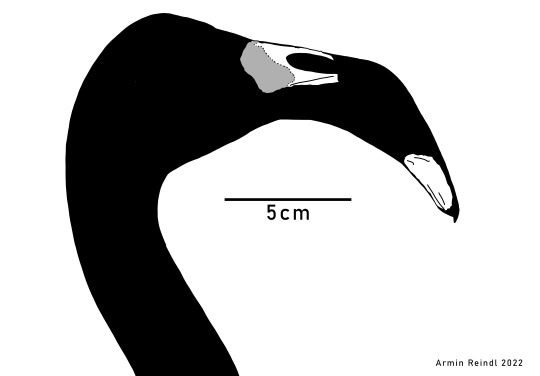
Leakeyornis aethiopicus is an extinct flamingo from the Miocene of East Africa known from a lot of material, but most intriguingly skull parts (which I've found increasingly rare while diving into fossil flamingos). Here is a basic interpretation of the material, the grey area showing elements that are too obscured by matrix (?). According to Rich et al. 1987, Leakeyornis might just be the smallest known fossil flamingo. Keep in mind tho, this is just one interpretation I got while keeping the material (two different fossils) at the same size they would be in life. So it's easily possible that one could have belonged to a larger or smaller bird and thus change the proportions. The angle of the beak is likewise more just a guess.
25 notes
·
View notes
Photo

BRADFORDIA LIOMPHALE Fossil Ammonite – Inferior Oolite, Jurassic Coast, Burton Bradstock, Dorset, UK
This listing features a beautifully preserved Bradfordia liomphale fossil ammonite discovered in the iconic Inferior Oolite strata of the Jurassic Coast at Burton Bradstock, Dorset, UK. This rare and scientifically notable ammonite dates back to the Middle Jurassic period and is an excellent example of the intricate shell structure and evolutionary significance of ammonites during this era.
Geological Unit: Inferior Oolite Group
Formation: Burton Bradstock Beds
Geological Period: Middle Jurassic
Stage: Early Bajocian
Biozone: Parkinsonia zone (based on locality association)
Depositional Environment: Shallow marine carbonate platform
Order: Ammonitida
Superfamily: Stephanoceratoidea
Family: Morphoceratidae
The specimen was carefully unearthed by our dedicated fossil hunters, Alister and Alison, on 17 January 2025. Following discovery, it was meticulously cleaned, stabilised, and prepped by Alison to highlight its ribbed pattern, detailed coiling, and preserved sutures.
Your fossil is set within a natural matrix from the site, retaining context from its original stratigraphic layer. A scale cube (1cm) is included in the photos for precise sizing—please refer to the image for complete dimensions. The photo represents the exact item you will receive.
All of our Fossils are 100% Genuine Specimens & come with a Certificate of Authenticity.
Whether you're an experienced fossil collector, a museum educator, or a geological enthusiast, this authentic ammonite fossil is a valuable and impressive addition to any collection.
#Bradfordia liomphale fossil#Jurassic ammonite#Burton Bradstock ammonite#Dorset fossil#ammonite UK fossil#certified ammonite#ammonite collector item#Inferior Oolite ammonite#fossil from Jurassic Coast#Mesozoic marine fossil#rare ammonite species#ammonite matrix fossil
0 notes
Text
OPERATOR FILE 3: STONEDGE.
ROARK'S LAB
A hybrid space constructed for his hobbies, Roark's lab doubles as a cleanroom and a museum, a host for the interesting specimens he has found over his last few years of onboarding. Roark primarily specializes in excavation of bones and artifacts, but has an eye for geological specimens and rare stones. The majority of his collection, unsurprisingly, is animal bones and the occasional person. Much of these have to do with Roark's personal curiosity surrounding why ancient races, like he is, are much more susceptible to oripathy, and believes some of those answers may lie in preserved remains. Rhodes graciously allows him to perform as much exanimation and analysis as he can, and what he has learned in order to do this comes from the texts and people on Rhodes to begin with.
His exhibition area does have some mostly full skeletons pieced together, carbon dating going back millions of years ago. Traces of originium have been found in some of these remains, theorizing the way in which originium particles interacted with flesh long before the introduction of modern science. Roark takes great pride in teaching people about what he's found, and can often be found in the clean room picking away at a matrix, or explaining excitedly to other operators about a specimen they're in front of.
If Roark is away from Rhodes, it is typically due to dispatching for a mission, or he's off digging away in a suitable location for fossils.
Interestingly enough, some art pieces have also found their way into his exhibition area…
OTHER HOBBIES
Cooking:
Strangely enough, Roark has also been spotted somewhat regularly using Rhodes' kitchen for various cooking experiments. It seems to be his primary method of interacting with fellow operators outside of dispatch, and the mess hall is as aromatic as ever when he's around. Some homemade recipes have been introduced into the rotation of food available, such as soups and an expansion of ways to marinate meats. He's even gone as far as showing how to make these dishes with fellow operators, regardless of his level of acquaintanceship with them. Much of his kitchen messes are primarily due to his tail bumping into things and not so much burning food by accident.
Rhodes staff has approached him about his frequency of being in there preparing food at the wee hours of the morning, and although by no means malicious, it was somewhat out of character with his typical routine. Plain and honest, Roark explained it was due to working around operator Wildcharge's nocturnal and inconsistent appetite. He doesn't have any issues with it, though, joyful over sharing a little bit of his favorite pastimes with fellow colleagues. He very much embodies the air of an old, well-loved home.
Preservation:
Seldom seen, but Roark's archeological surveys have also branched into some general interest into preserving organisms as well. There are quite little out on display, given the nature of what catastrophes can do to the land, and anything within it, but some of his medical staff colleagues have confirmed his occasional request for an aggressive amount of ethanol and some jars for formalin. Operators typically have to ask Roark to see some his taxidermy. Many of these hail from Sargon, where very little tends to pierce the treetops and prevents the sun from damaging specimens before they're found.
#🗻 ━ 𝗍𝗁𝖺𝗍'𝗌 𝗐𝗁𝗒 𝗍𝗁𝖾𝗒 𝖼𝖺𝗅𝗅 𝗆𝖾 𝖺 𝗋𝗈𝖼𝗄. / roark hc.#🌑 ━ 𝗈𝗉 𝗇𝖺𝗆𝖾 𝗌𝗍𝗈𝗇𝖾𝖽𝗀𝖾. / arknights verse.#long post#🌑 ━ 𝗂𝗍'𝗌 𝖺 𝖿𝗂𝗀𝗁𝗍 𝗍𝗈 𝗌𝗎𝗋𝗏𝗂𝗏𝖾 𝗐𝗁𝖾𝗇 𝗅𝗂𝖿𝖾 𝗂𝗌 𝖺𝗅𝗅 𝗒𝗈𝗎 𝗁𝖺𝗏𝖾. / arkn hc.
3 notes
·
View notes
Text
Nuzlocke updates!
Immediately after the Gym, May ambushed us outside.
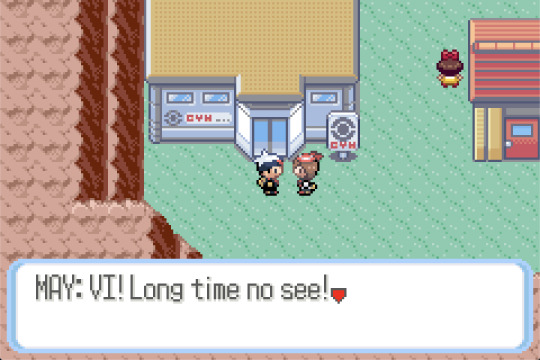
Ah! Hi May! You startled me!

Yeah, I’m actually dreading our next fight a little, but I think Matrix is a good counter to your Combusken.

Uh.
Did May just threaten to fuck my dad?

(Pic courtesy of @lovelylovelyartist)
On that note, we went to one of my most highly anticipated areas of the run! The nice sandstormy area. May gave us the Go-Goggles. How stylish? So we could see well enough to find this friend!

(Max was also kind enough to suggest a name.) Meet Dusty!
At that point, it was on to grinding. I also picked up a Claw Fossil from the sand, but I’m a little torn on whether or not I can use it.
Normally, I go by the area I received a Pokemon. So in the case of Tammi, I got her egg in a town where I hadn’t already caught a Pokemon, then hatched her. If I received the Claw Fossil in the same place as Dusty, but revive it somewhere else, does it count as an encounter for where I revived it, or where I got the fossil (like an egg)? Let me know your thoughts!
There were a couple of spots felt scary in this area, like Pin Missile on Cacnea!

But we pulled through.
I pulled Ren from the PC in preparation for Dad’s Gym in Petalburg, which is of course full of Normal Types. We trained, then went back to Petalburg to try our hand against a few of the Gym Trainers. Ren was taking enough damage that i feared a critical hit, so I swapped to Sand for a while, but he’s a bit underleveled. He did great for several turns with some healing, though!

When Ren reached level 27, there were only a couple of trainers left. One of them was the one-hit KO room. The name scared me, and Ren definitely needed some more levels, so we looped back around through Rusturf Tunnel to train up. There, we challenged the Winsrate Family!

And with Ren nearly ready to level up, I temporarily forgot that grinding near Petalburg takes a while and the whole point of being here was to get more EXP. I headed back to Mr Briney to-
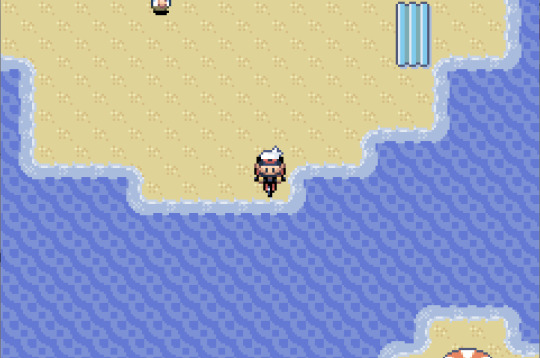
Uh. Mr Briney?
Oh, right. I biked here and left him by Petalburg.
Well, no matter! Back to training.

On the way, Ren evolved! We trained a little bit more, then I used one of the Rare Candies to bring him to a clean level 30. It was time to challenge the last room. According to Google, it’s not a one-hit KO move room, it’s a high critical hit ratio room. Crits are scary, but I felt a bit more confident with the levels up. Still, I was a bit nervous.

I know, I know!

But then Ren got a 1-hit KO!
Next time, we challenge Dad.
3 notes
·
View notes
Photo

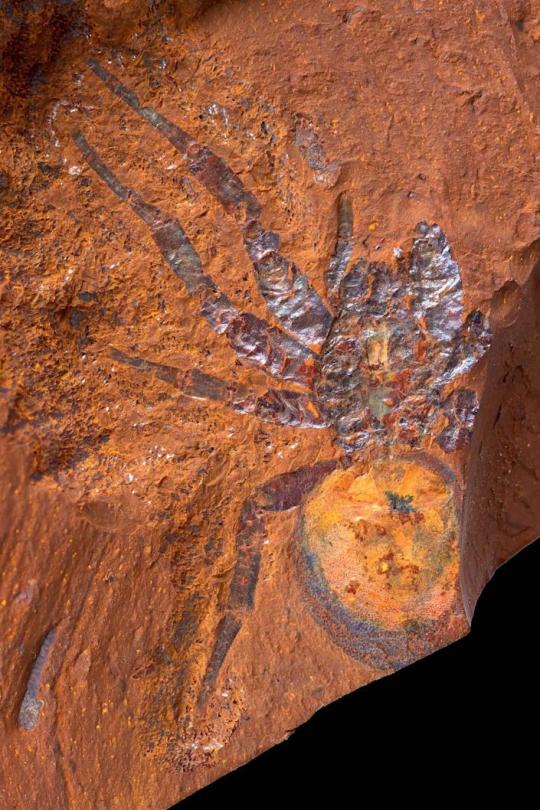


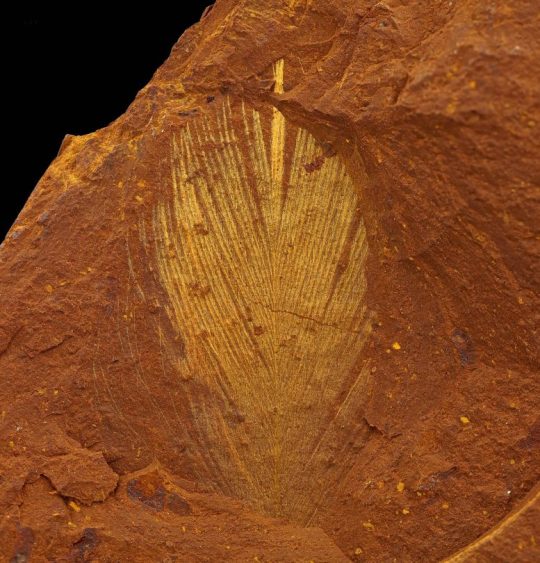



Rare and Fragile Fossils Found at a Secret Site in Australia
Buried in Australia's so-called dead heart, a trove of exceptional fossils, including those of trapdoor spiders, giant cicadas, tiny fish and a feather from an ancient bird, reveal a unique snapshot of a time when rainforests carpeted the now mostly-arid continent.
Paleontologists discovered the fossil treasure-trove, known as a Lagerstätte ("storage site" in German) in New South Wales, in a region so arid that British geologist John Walter Gregory famously dubbed it the "dead heart of Australia" over 100 years ago. The Lagerstätte's location on private land was kept secret to protect it from illegal fossil collectors, while scientists excavated the remains of plants and animals that lived there sometime between 16 million and 11 million years ago.
The researchers unearthed remains that are unique in the Australian fossil record for the Miocene Epoch (23 million to 5.3 million years ago), they reported in a new study. Most of the prior Miocene finds that other scientists have unearthed in Australia were bones and teeth from larger animals — which are commonly preserved in Australia's dry landscapes. However, the new cache held fossils of small and delicate creatures such as spiders and insects, as well as flora from the Miocene rainforest.
By examining the well-preserved fossils with scanning electron microscopes (SEM), the study authors were able to image details as fine as individual cells and subcellular structures. Some of the images even revealed animals' last meals, such as fish, larvae and a partially digested dragonfly wing preserved inside fishes' bellies. In other fossilized scenes, a freshwater mussel clung to a fish's fin, and pollen grains were stuck to insects' bodies.
"This site gives us unprecedented insight into what these ecosystems were like," lead study author Matthew McCurry, a curator of paleontology at the Australian Museum, told Live Science in an email. "We now know how diverse these ecosystems were, which species lived in them and how these species interacted."
Paleontologists first visited the site — now named McGraths Flat — in 2017, after a farmer reported finding fossilized leaves in one of his fields. When the scientists investigated, "we were pleased to discover that the site yields a much wider range of fossils, including the remains of insects, spiders and fishes," McCurry said.
The fossil-bearing rock layer measures between 11,000 and 22,000 square feet (1,000 and 2,000 square meters), and paleontologists have thus far excavated just over 500 square feet (50 square m), according to McCurry. A matrix of iron-rich rock called goethite surrounded the fossils on top of a layer of sandstone. Plants and animal remains in a stagnant pool were likely encased in iron and other minerals after runoff from nearby basalt cliffs drained into the pool, known in Australia as a billabong, which preserved them in exquisite detail.
Now, millions of years later, researchers have begun piecing together the fossils to build a portrait of an extinct Australian rainforest. They found leaves from flowering plants, pollen, fungal spores, more than a dozen specimens of fish, "a wide diversity of fossilized insects and arachnids," and a feather from a bird that was about the size of a modern sparrow, the study authors reported. Analysis of the preserved leaves suggests that the average temperature at the time was about 63 degrees Fahrenheit (17 degrees Celsius).
"I find the spider fossils the most fascinating," McCurry said. Until now, only four fossil spiders were known from Australia, and researchers have so far found 13 spider fossils at McGrath Flats, McCurry said.
Preserved soft tissues in the feather and in the fishes' eyes and skin held another exciting detail: pigment-storing cell structures called melanosomes. Though the color itself isn't preserved, scientists can compare the shape, size and stacking patterns in the fossil melanosomes to those in modern animals. In doing so, paleontologists can often reconstruct the colors and patterns in extinct species, study co-author Michael Frese, an associate professor of science at the University of Canberra in Australia, said in a statement.
While much has been discovered at McGraths Flat, "this is really only the beginning of the work on the fossil site," McCurry said. "We now know the age of the deposit and how well-preserved the fossils are, but we have years of work ahead of us to describe and name all of the species we are finding. I think that McGraths Flat will become extremely important in building a more accurate picture about how Australia has changed over time."
By Mindy Weisberger.
#Rare and Fragile Fossils Found at a Secret Site in Australia#dead heart of australia#McGraths Flat#paleontologists#ancient fossils#history#history news
17 notes
·
View notes
Text
Item List for the Sale of 04/25/21
To claim an item please comment on the original item post and message me your info. :) The complete rules can be found here. Invoices sent after the due date are due upon receipt. 1. 1.5" large tumbled palm root fossil
2. 1.5" extra large tumbled chrysoprase - Sold out!
3. 1" chunky tumbled blue sapphire - Sold out!
4. 1" chunky tumbled chatoyant ruby
5. 1.5" large tumbled cavansite in matrix
6. 1.25" large tumbled purple chalcedony - Sold out!
7. 1" tumbled lavender jade from Turkey - Sold out!
8. 2" - 2.5" extra large tumbled thulite
9. 1.5" large tumbled red moss agate - Sold out!
10. 1.5" rare dumortierite in quartz - Sold out!
11. 1.5" rare mango quartz
12. 0.5" kunzite crescent moons
13. 1.25" high quality lepidolite hearts
14. 2.5" large polished garnet crystals - Sold out!
15. 1.75" amethyst bottle pendants - Sold out!
16. 1.5" amethyst bottle pendants - Sold out!
17. 2.5" native copper from Michigan - Sold out!
18. 1.5" ruby in epidote spheres - Sold out!
19. 0.8" rainbow fluorite stars
20. 0.8" rainbow fluorite crescent moons
21. 2" phosphosiderite palm stones
22. 5" rainbow fluorite points - Sold out!
23. 1.5" rough shungite
24. 2" rare Uvarovite garnet
25. 0.8" shungite spheres
26. 1" rare chrome dioptase
27. 1" vibrant vivianite from Romania
28. 1.5" rough stichtite from Russia
29. 1.5" rough iowaite from Russia
30. 1.25" charoite pyramids
31. 3.25" high quality charoite wands
32. 3.5" masterfully hand-carved charoite skull - Sold out!
33. Rare kammererite palm stones
34. Rare morganite from Russia
35. Cordierite from Russia
36. Datolite from Russia
37. Dianite aka Russian blue jade
38. Rare rodingite from Kazakhstan
39. Extra large one side polished stichtite
40. High quality polished charoite slabs
41. Top quality seraphinite stalactite slices
42. Rare kobyashevite on aragonite with tiny selenite crystals
43. Rare dumortierite in quartz crystals
44. Large genuine moldavite pieces
45. Genuine moldavite sterling silver pendants - Sold out!
46. High quality phantom amethyst vogel wands
34 notes
·
View notes
Photo


Incredible, 30" Fossil Turtle (Apalone) - Green River Formation
This a huge, museum quality, soft-shelled turtle (Apalone heteroglypta) from the Green River Formation of Wyoming. It measures 30 inches long (tip of skull to end of tail) and is nicely centered on a natural, 45 x 38" slab of shale. One of the aspects that makes this piece so special is that there is almost no restoration. There is only about 1% restoration along repaired cracks. None of the fossil has been composited or reposition on the rock, and the matrix is original. This spectacular piece has wall mounting hardware installed, so it is ready to show off. These turtles are a very rare component of the Fossil Lake fauna. This one was collected from the famous 18 inch layer of the Green River Formation. This layer is known for it's exceptional fossil preservation because it was deposited in a few low oxygen environment. Nearly all the fossils in this layer are still buried under the surface of the rock when found. In the quarries they collected this layer at night using spotlights at low angles. This creates shadows off of the raised portions of the rock which indicate a buried fossil. The rock must then be carefully removed using air-scribes and air abrasives, an extremely time consuming process.
For sale at FossilEra.com
440 notes
·
View notes